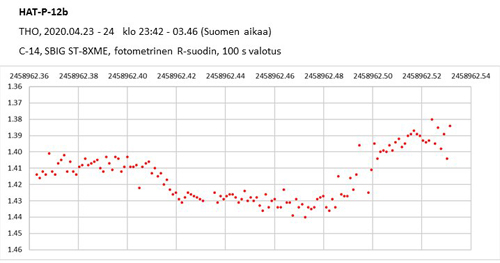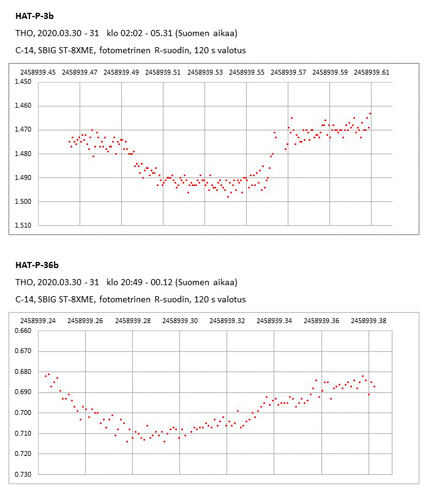Abstract
Taurus Hill Observatory (THO) [1], observatory code A95, is an amateur observatory located in Varkaus, Finland. The observatory is maintained by the local astronomical association Warkauden Kassiopeia. THO research team has observed and measured various stellar objects and phenomena. Observatory has mainly focused on exoplanet light curve measurements, observing the gamma rays burst, supernova discoveries and monitoring [2]. We also do long term monitoring projects [3] [4].
The results and publications that pro-am based observatories, like THO, have contributed, clearly demonstrates that pro-amateurs are a significant resource for the professional astronomers now and even more in the future.
High Quality Measurements
The quality of the telescopes and CCD-cameras has significantly developed in 20 years. Today it is possible for pro-am's to make high quality measurements with the precision that is scientifically valid. In THO we can measure exoplanet transits < 10 millimagnitude precision when the limiting magnitude of the observed object is 15 magnitudes. At very good conditions it is possible to detect as low as 1 to 2 millimagnitude variations in the light curve.
Exoplanet Transit Observations in THO
To this date the team has measured over 70 different exoplanet light curves, some of them several times. Most of the transit measurements have been stored in the EDT (Exoplanet Transit Database) maintained by Variable Star and Exoplanet of Czech Astronomical Society.
Here are some recent examples of the exoplanet measurements from THO. In Figure 1 below is the exoplanet measurement of the exoplanet HAT-P-12b. The exoplanet is located 468 light-years away. It’s probably a hot gas giant about Jupiter in diameter, orbiting its parent star in 3.2 days. In this measurement, the brightness of the parent star dimmed by 31 mmag due to transit. The transit took about 147 minutes.

Figure 1: HAT-P-12b light curve 22./23.4.2020; C-14, Paramount MEII, SBIG ST-8XME.
Second example concerns two measurements from the same night. HAT-P-3b and HAT-P-36b exoplanet transits were observed on 30./31.3.20202 (Figure 2).

Figure 2: HAT-P-3b and HAT-P-36b 30./31.3.20202; C-14, Paramount MEII, SBIG ST-8XME.
Third example (Figure 3) concerns about KPS-1b exoplanet transit observation. Despite the rather hazy sky, however, the transit of the planet was visible in the light curve reasonably well.

Figure 3: KPS-1b 22./23.3.2020; C-14, Paramount MEII, SBIG ST-8XME.
Summary and Conclusions
Taurus Hill Observatory and other similar pro-amateur based observatories have a good record in field of astronomy and especially in the light curve measurements and photometric monitoring.
The research teams have the knowledge for making a good and high quality photometric light curve measurements. The publication records are one of the good examples from this knowledge. In the future the THO research team aims for more challenging astronomical research projects with professional astronomers and observatories.
As a conclusion it can be stated that it is possible to do high quality astronomical research with pro-amateur astronomy equipment if you just have the enthusiasm and knowledge to use your equipment in the right way.
Acknowledgements
The Taurus Hill Observatory will acknowledge the cooperation partners, Pulkova Observatory, Finnish Meteorological Institute and all financial supporters of the observatory.
References
[1] Taurus Hill Observatory website, http://www.taurushill.net
[2] A low-energy core-collapse supernova without a hydrogen envelope; S. Valenti, A. Pastorello, E. Cappellaro, S. Benetti, P. A. Mazzali, J. Manteca, S. Taubenberger, N. Elias-Rosa, R. Ferrando, A. Harutyunyan, V.-P. Hentunen, M. Nissinen, E. Pian, M. Turatto, L. Zampieri and S. J. Smartt; Nature 459, 674-677 (4 June 2009); Nature Publishing Group; 2009.
[3] A massive binary black-hole system in OJ 287 and a test of general relativity; M. J. Valtonen, H. J. Lehto, K. Nilsson, J. Heidt, L. O. Takalo, A. Sillanpää, C. Villforth, M. Kidger, G. Poyner, T. Pursimo, S. Zola, J.-H. Wu, X. Zhou, K. Sadakane, M. Drozdz, D. Koziel, D. Marchev, W. Ogloza, C. Porowski, M. Siwak, G. Stachowski, M. Winiarski, V.-P. Hentunen, M. Nissinen, A. Liakos & S. Dogru; Nature - Volume 452 Number 7189 pp781-912; Nature Publishing Group; 2008
[4] Transit timing analysis of the exoplanet TrES-5 b. Possible existence of the exoplanet TrES-5 c; Eugene N Sokov, Iraida A Sokova, Vladimir V Dyachenko, Denis A Rastegaev, Artem Burdanov, Sergey A Rusov, Paul Benni, Stan Shadick, Veli-Pekka Hentunen, Mark Salisbury, Nicolas Esseiva, Joe Garlitz, Marc Bretton, Yenal Ogmen, Yuri Karavaev,Anthony Ayiomamitis, Oleg Mazurenko, David Alonso, Sergey F Velichko; Monthly Notices of the Royal Astronomical Society, Volume 480, Issue 1, October 2018, Pages 291–301, https://doi.org/10.1093/mnras/ sty1615



